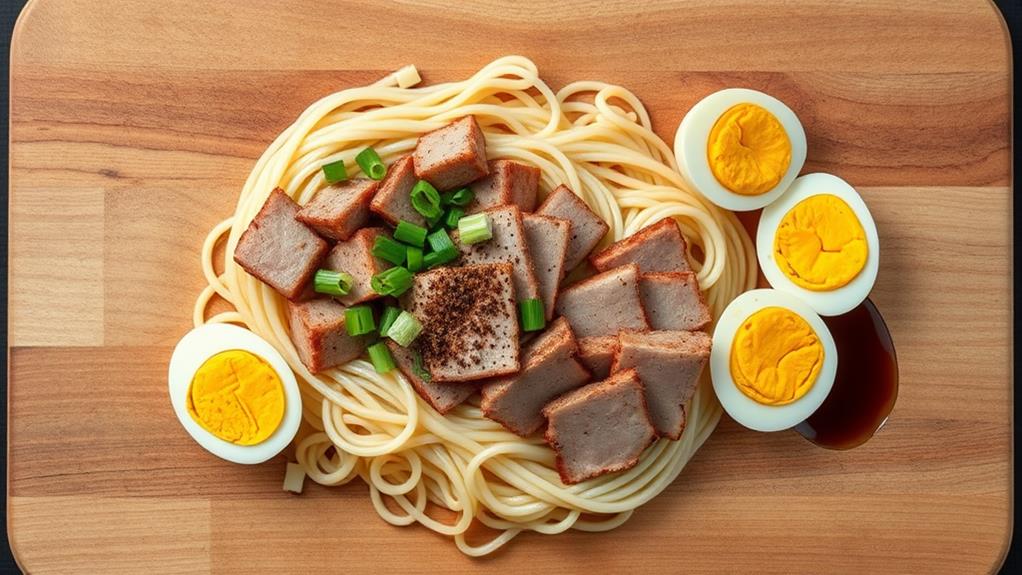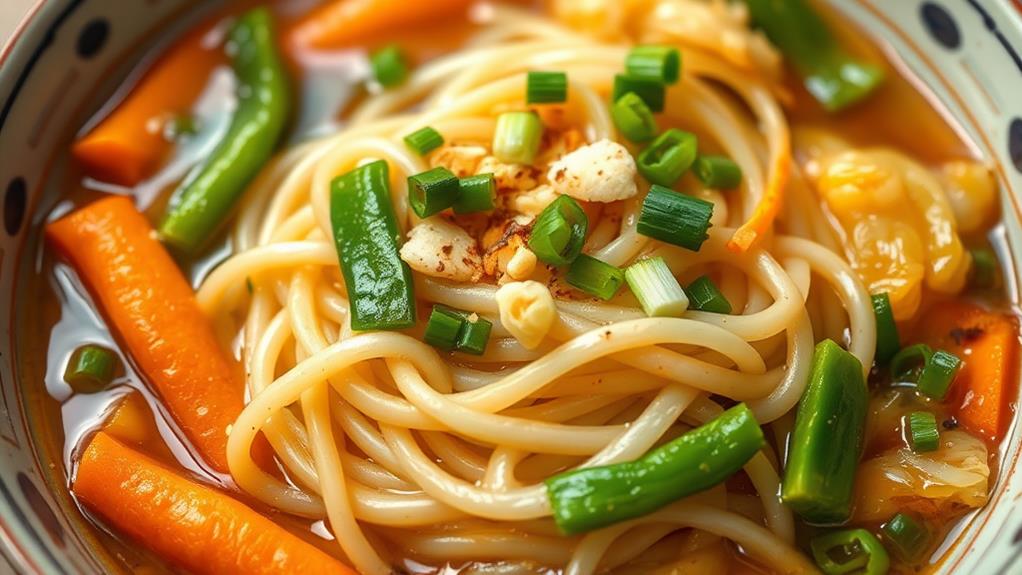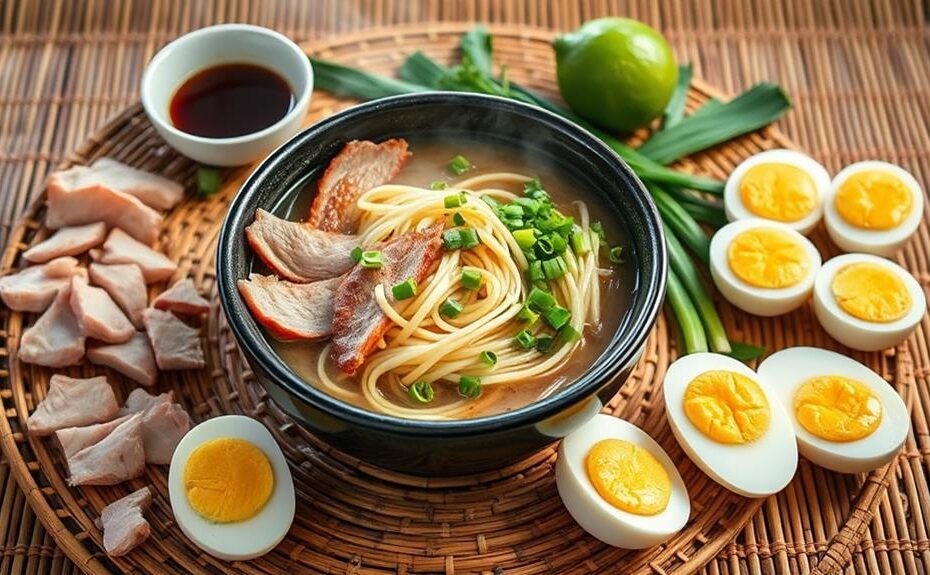Three Essential Ingredients for Authentic Filipino Lomi
To create a genuine Filipino Lomi, three crucial components are necessary.
Fresh egg noodles, specifically designed for Lomi, provide a chewy texture that absorbs the flavorful broth perfectly. Without these noodles, the dish's signature texture is lost.
A protein-packed combination is the second essential ingredient. This mix typically includes pork belly, chicken, liver, squid balls, and kikiam, which add richness to the dish. The variety of proteins creates a depth of flavor that is characteristic of Filipino Lomi.
A savory chicken broth thickened with cornstarch slurry is the third essential ingredient. This broth is the foundation of the dish, and its thickness is a hallmark of Filipino Lomi.
The cornstarch slurry helps to achieve the perfect consistency, which is neither too thick nor too thin.
Key Ingredients for Authentic Lomi

Authentic Lomi Noodles: Fresh egg noodles, specifically labeled as Lomi noodles, are essential for creating authentic Filipino Lomi. These noodles have a chewy texture that allows them to absorb the flavorful broth, making them a crucial component of the dish.
Protein Selection: Pork belly is a popular protein choice for Lomi, adding richness and depth to the dish. Other options include chicken, liver, and various meatballs such as squid balls and kikiam.
These proteins are simmered in a savory chicken broth, which is thickened with a cornstarch slurry to achieve the signature thick soup.
Aromatics and Seasoning: Garlic, onions, carrots, and napa cabbage are added to balance out the flavors.
The dish is then seasoned with soy sauce, fish sauce, and salt to bring out the savory flavors.
Building a Savory Broth Base
Building a Savory Broth Base for Filipino Lomi
A Rich Foundation of Flavor
A savory broth base for authentic Filipino Lomi starts with a combination of water and pork or chicken broth. This foundation is crucial, setting the tone for the entire dish.
Layering Flavors
To build the broth, sauté aromatics like garlic and onions in oil until they're soft and fragrant.
Then, add seasonings and bouillon, including soy sauce, which balances the richness of the broth.
For added convenience, use a Knorr chicken cube to add depth to the flavor without extra effort.
Simmering Meats
Slowly simmer meats like pork belly and liver to tenderize them to perfection and infuse the broth with heartiness.
This slow simmering process allows the flavors to meld and the broth to thicken.
The Result
With patience and attention to detail, you'll end up with a savory broth base that's the perfect foundation for your authentic Filipino Lomi.
Can I Use Similar Ingredients for Lomi and Pancit Canton?
Yes, you can use some of the essential ingredients for pancit canton in lomi as well. Both dishes commonly contain similar ingredients such as noodles, vegetables, and protein like pork or chicken. However, the key difference lies in the broth and seasoning used, which give each dish its distinct flavor.
Essential Noodles and Vegetables

Essential Noodles and Vegetables
Thick Fresh Egg Noodles
Thick fresh egg noodles, known as lomi noodles, are essential for the characteristic chewy texture of Filipino Lomi. To prevent them from becoming mushy, blanch them in boiling water for 30 seconds.
Common Vegetables
Common vegetables used in Lomi include napa cabbage, carrots, and onions, which add flavor and nutrition to the hearty soup.
Sautéed garlic and onions form the aromatic base of the dish, enhancing the overall flavor profile when combined with the broth and other ingredients. You can incorporate seasonal vegetables for added freshness, but traditional Lomi variations often focus on a limited selection to maintain a more meat-centric dish.
Combining Noodles and Vegetables
Frequently Asked Questions
What Is the Composition of Lomi?
Lomi's composition typically features a mix of textures. This is achieved through the combination of chewy noodles, tender meats, and crunchy vegetables.
The flavors of Lomi are complex and multifaceted. The dish is characterized by a savory broth, umami spices, and a hint of acidity.
The presentation of Lomi is simple yet inviting. Garnishes are often used to add a pop of color to the dish.
What Are the Best Toppings for Lomi?
Crispy garlic and chicharrón bits add a satisfying crunch to Lomi. These toppings provide a pleasing textural contrast to the dish.
Boiled eggs bring creaminess to Lomi. They add moisture and richness to each bite.
Fresh green onions introduce a pop of color and mild flavor to Lomi. They add a freshness that complements the other toppings.
For added depth, calamansi juice, fried tofu, or shrimp can be used as toppings. These options enhance the flavor profile of Lomi.
Sliced mushrooms and pork belly (lechon kawali) are also delicious options for Lomi toppings. They add an earthy flavor and a satisfying bite.
If you like a little heat in your Lomi, sprinkle some pepper flakes on top. This adds a spicy kick to the dish.
What Is Batangas Lomi Made Of?
Batangas Lomi is a Filipino dish made with thick, chewy noodles. These noodles set it apart from other lomi types.
The savory broth is made with pork and chicken. It's simmered with aromatics and spices, including soy sauce and fish sauce.
Batangas Lomi is typically served with sliced pork belly, liver, and squid balls. It's garnished with scallions and veggies, showcasing the dish's cultural significance.
Is Lomi Chinese or Filipino?
Lomi is a Filipino dish with Chinese roots. It originated from Chinese cuisine, specifically Lor Mee, but was adapted and integrated into Filipino culture.
The Filipino adaptations made Lomi a staple with its own cultural significance and popularity.
Across the Philippines, you'll find unique variations of Lomi, showcasing regional differences in noodle types, cooking methods, and flavor profiles.
These variations demonstrate the dish's evolution and significance in Filipino culture.
While Lomi has Chinese origins, it's undoubtedly a beloved Filipino dish with a distinct identity.
